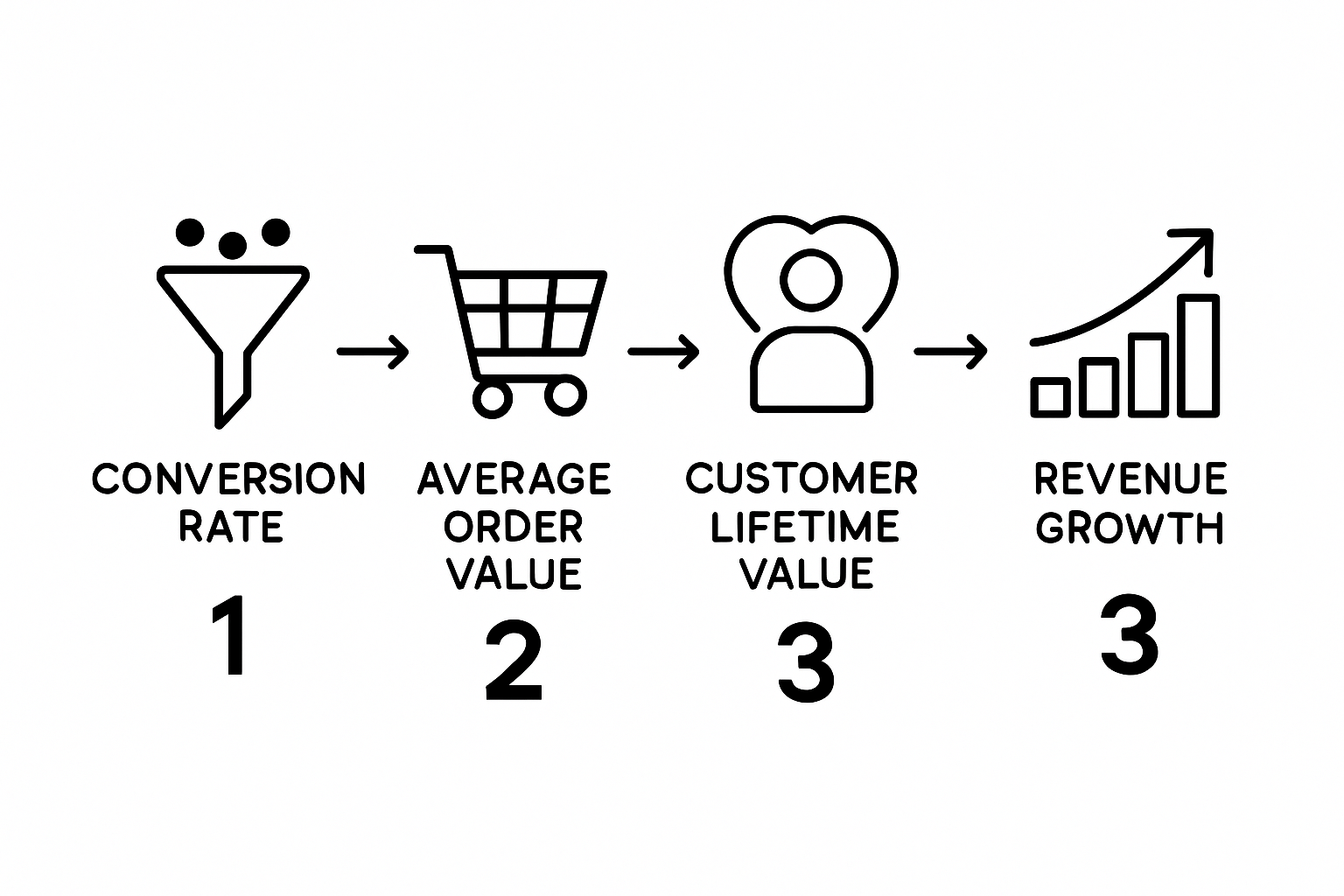
E-commerce stores run on more than just flashy products and good intentions. Some stores analyze every click, tracking metrics like conversion rates and customer retention that can raise revenue by over 30 percent. Most store owners think gathering all that data is overwhelming or only matters if you already have a big audience. Yet even small tweaks to how you choose or use your numbers can unlock hidden profits and give you a real edge fast.
Table of Contents
Quick Summary
| Key Point | Explanation |
| 1. Define Relevant KPIs | Identify Key Performance Indicators that align with your business goals for effective analysis and tracking. |
| 2. Organize Your Data | Gather and structure comprehensive data from multiple sources to enable accurate analysis of store performance. |
| 3. Analyze Customer Behavior | Segment customers to uncover purchasing patterns and trends that inform marketing and product strategies. |
| 4. Create Actionable Insights | Transform data findings into a prioritized action plan targeting high-impact changes for your e-commerce business. |
| 5. Monitor and Adjust Continuously | Implement regular performance tracking and adapt strategies based on real-time data insights for ongoing improvement. |
Step 1: Define Your Key Performance Indicators
Successful e-commerce data analysis begins with identifying the right Key Performance Indicators (KPIs) that reveal genuine insights about your store’s performance. Think of KPIs as the critical compass guiding your business strategy, transforming raw data into actionable intelligence that drives revenue growth.
Starting your data analysis journey requires understanding which metrics truly matter for your specific business model. While every online store is unique, there are fundamental KPIs that provide universal insights. Revenue metrics like total sales, average order value, and conversion rates form the foundational layer of your analytical framework. Customer-centric metrics such as customer lifetime value, repeat purchase rate, and acquisition cost complement these financial indicators.
To select the most relevant KPIs, consider your specific business goals and current growth stage.
 A new e-commerce store might prioritize customer acquisition metrics, while an established store could focus more on retention and profitability indicators. Learn more about advanced marketplace analytics to refine your strategic approach.
A new e-commerce store might prioritize customer acquisition metrics, while an established store could focus more on retention and profitability indicators. Learn more about advanced marketplace analytics to refine your strategic approach.
Your KPI selection process should involve systematic evaluation. Break down your primary business objectives into measurable components. For an e-commerce store, this might include increasing average order value, reducing cart abandonment rates, improving customer retention, or expanding product category performance. Each objective translates into specific, trackable metrics that provide clear insights into your store’s health and potential growth opportunities.
Key verification steps for your KPI definition include ensuring each indicator is SMART: Specific, Measurable, Achievable, Relevant, and Time-bound. Avoid vanity metrics that look impressive but offer little strategic value. Instead, focus on indicators that directly connect to your revenue generation and business expansion goals. Regularly review and adjust these KPIs as your business evolves, maintaining a dynamic and responsive analytical approach that keeps pace with your store’s growth trajectory.
Below is a checklist table to help you verify and refine your chosen Key Performance Indicators (KPIs) for maximum impact and alignment with your e-commerce goals.
| KPI Verification Criteria | Description | Action Required |
| Specific | Clearly defines what is being measured | Break down general goals |
| Measurable | Quantifiable with reliable data sources | Use actual store data |
| Achievable | Realistic within your business resources and timelines | Assess current capabilities |
| Relevant | Directly impacts your revenue or growth | Eliminate vanity metrics |
| Time-bound | Has a defined timeframe for evaluation | Set regular review periods |
| Regularly Reviewed | Adjusted as your business evolves | Schedule periodic evaluations |
| Actionable | Leads to clear strategic decisions | Prioritize meaningful metrics |
Step 2: Gather and Organize Your E-Commerce Data
Data collection represents the critical foundation of meaningful e-commerce analysis, transforming raw information into strategic insights that drive business growth. Your goal in this step is to compile comprehensive, clean, and structured data that provides a holistic view of your online store’s performance.
Begin by extracting data from multiple sources to create a robust dataset. Key data repositories include your e-commerce platform (like Shopify or WooCommerce), payment processor records, web analytics tools, and customer relationship management systems. Explore our guide on purchase data collection to understand the nuanced approaches for comprehensive information gathering.
Precision matters when consolidating these data streams. Export detailed transaction logs that capture critical information such as product details, customer demographics, purchase timestamps, order values, shipping information, and return histories. Most platforms offer CSV or spreadsheet export functionalities that simplify this process. Pay special attention to maintaining data integrity by checking for duplicate entries, correcting formatting inconsistencies, and ensuring all critical fields are populated.
This tools and resources table summarizes the key platforms and applications recommended for effective data gathering and organization in your e-commerce analysis process.
| Tool/Platform | Purpose | Example Use Case |
| E-commerce Platform | Source for transaction and product data | Export order history from Shopify |
| Payment Processors | Provide payment and refund records | Gather Stripe or PayPal transaction logs |
| Web Analytics Tools | Track traffic, conversions, and user behavior | Analyze visitor flow with Google Analytics |
| CRM Systems | Manages customer demographic information | Segment customers in HubSpot |
| Spreadsheet Software | Organize, clean, and analyze raw data | Structure datasets in Excel or Google Sheets |
| Data Management Apps | Automate and centralize data collection | Use Airtable or Zapier for integrations |
Organizing your data requires creating a systematic filing structure that allows for easy analysis and future reference. Develop a consistent naming convention for your files, including date stamps and specific identifiers. Create separate folders for different data types like sales records, customer information, product catalogs, and marketing campaign metrics.
 Digital tools like Google Sheets, Microsoft Excel, or specialized data management platforms can help streamline this organizational process.
Digital tools like Google Sheets, Microsoft Excel, or specialized data management platforms can help streamline this organizational process.
To verify your data collection and organization is successful, conduct a comprehensive audit. Check that your dataset includes complete records with minimal gaps, represents a statistically significant time period (typically 3-6 months), and covers all relevant business operations. Ensure your data is clean, consistent, and ready for the advanced analytical techniques you will apply in subsequent steps of your e-commerce data analysis journey.
Step 3: Analyze Customer Behavior and Trends
Customer behavior analysis transforms raw data into strategic insights that illuminate the complex decision-making patterns driving your e-commerce success. This critical step goes beyond surface-level observations, diving deep into understanding the psychological and transactional dynamics that influence purchasing decisions.
Begin by segmenting your customer base using multidimensional criteria such as purchase frequency, average order value, product preferences, and engagement levels. Explore our detailed market basket analysis approach to uncover intricate product relationship patterns that can revolutionize your sales strategy. Look for nuanced trends like seasonal purchasing behaviors, cross-category buying patterns, and customer lifetime value trajectories.
Utilize advanced analytical techniques to decode customer journeys. Examine conversion funnels to identify precise points of customer drop-off, analyze time spent on product pages, and track the effectiveness of different marketing channels. Pay special attention to cohort analysis, which allows you to compare customer groups based on shared characteristics or acquisition periods. This method reveals how different customer segments interact with your store, providing granular insights into purchasing behaviors.
Customer retention and engagement metrics offer profound strategic intelligence. Calculate key indicators like repeat purchase rate, customer lifetime value, and churn probability. These metrics help you understand not just who is buying, but why they continue to choose your store. Look for patterns in product combinations, timing of repeat purchases, and the impact of promotional strategies on customer loyalty.
To verify the effectiveness of your analysis, create a comprehensive customer behavior report that includes clear visualizations of key trends, actionable insights, and potential strategic interventions. Your goal is to transform complex data into a clear narrative that guides targeted marketing efforts, product development, and customer experience improvements. Successful analysis means you can now predict and proactively shape customer purchasing behaviors, turning data into a powerful competitive advantage.
Step 4: Create Actionable Insights from Your Analysis
Transforming complex data analysis into clear, executable strategies is the pivotal moment where your e-commerce insights become genuine revenue opportunities. This step bridges the gap between understanding your data and implementing meaningful improvements that directly impact your store’s performance.
Strategic interpretation requires looking beyond raw numbers to understand the underlying narratives within your data. Explore our comprehensive sales analysis strategies to develop a nuanced approach to insight generation. Identify specific patterns that reveal opportunities for product bundling, pricing adjustments, marketing refinements, and customer experience enhancements. For instance, if your analysis shows certain product combinations frequently purchased together, you can design targeted cross-sell strategies that naturally increase average order value.
Develop a systematic framework for translating analytical findings into concrete actions. Create a prioritized action plan that categorizes insights based on potential impact and implementation complexity. Focus on high-leverage opportunities that require minimal resource investment but promise significant returns. This might involve adjusting product placement, refining marketing messaging, optimizing pricing strategies, or creating personalized customer engagement campaigns based on behavioral trends discovered in your earlier analysis.
Effective insight generation demands a holistic view of your e-commerce ecosystem. Connect data points across different domains customer acquisition, product performance, marketing effectiveness, and operational efficiency. Look for interconnected insights that reveal broader strategic opportunities. For example, understanding that a specific customer segment responds more positively to video content can inform not just marketing strategies, but also product presentation and overall brand communication approach.
To verify the quality of your actionable insights, establish clear metrics for tracking the implementation and impact of each strategic recommendation. Create a dashboard that allows real-time monitoring of key performance indicators related to your proposed changes. Successful insight generation means you can confidently make data-driven decisions that are both strategically sound and directly tied to measurable business growth.
Step 5: Implement Changes Based on Insights
Implementing data-driven changes represents the critical moment where strategic insights transform into tangible business improvements. This step is about executing your analytical discoveries with precision, converting potential into measurable performance enhancements that directly impact your e-commerce store’s bottom line.
Begin by prioritizing insights based on their potential impact and ease of implementation. Learn more about implementing strategic sales changes to refine your approach. Focus first on high-leverage modifications that require minimal resources but promise significant returns. This might involve adjusting product pricing, redesigning product pages, optimizing checkout processes, or creating targeted marketing campaigns informed by your customer behavior analysis.
Develop a structured implementation roadmap that breaks down complex changes into manageable, incremental steps. For each insight, create a detailed action plan that specifies exact modifications, required resources, implementation timeline, and specific metrics for measuring success. Consider running controlled experiments or A/B tests to validate the potential impact of each proposed change. This approach allows you to mitigate risks and gather real-time data on the effectiveness of your strategic adjustments.
Technology plays a crucial role in seamless implementation. Utilize tools that enable rapid prototyping and testing, such as e-commerce platform native features, analytics integrations, and marketing automation software. These technologies allow you to quickly deploy changes, track performance, and make real-time adjustments. Pay special attention to user experience during implementation, ensuring that data-driven modifications enhance rather than disrupt the customer journey.
To verify successful implementation, establish a comprehensive monitoring system that tracks key performance indicators related to your changes. Create a dashboard that provides real-time visibility into metrics such as conversion rates, average order value, customer engagement, and revenue growth. Successful implementation means you can demonstrate clear, measurable improvements directly attributable to your data-driven strategic modifications, transforming insights into tangible business value.
Step 6: Monitor and Adjust Your Strategies Continuously
Continuous monitoring and strategic adaptation represent the lifeblood of successful e-commerce operations. This final step transforms your data analysis from a one-time exercise into a dynamic, responsive business optimization process that keeps your online store agile and competitive.
Real-time performance tracking becomes your primary strategic tool. Explore our comprehensive guide to maximizing revenue to understand the nuanced approach to ongoing business optimization. Establish a robust dashboard that provides immediate visibility into key performance indicators, allowing you to detect subtle shifts in customer behavior, sales trends, and operational efficiency. Integrate advanced analytics tools that offer predictive insights, helping you anticipate market changes before they significantly impact your business.
Develop a systematic approach to strategy adjustment that balances data-driven decision making with strategic flexibility. Create a quarterly review process where you comprehensively evaluate the performance of previous implementations, identifying both successful strategies and areas requiring refinement. This approach allows you to build an adaptive framework that evolves with your business and market conditions. Pay special attention to emerging trends, seasonal variations, and shifts in customer preferences that might necessitate rapid strategic pivots.
Technology plays a crucial role in maintaining continuous optimization. Leverage AI-powered analytics platforms that can provide automated insights, detect anomalies, and suggest potential improvements. These tools can help you move beyond reactive monitoring to predictive strategy development, enabling you to stay ahead of market trends and customer expectations. Implement automated alerts that notify you of significant performance changes, allowing for swift and targeted interventions.
To verify the effectiveness of your continuous monitoring strategy, establish clear benchmarks and create a comprehensive reporting system that tracks long-term performance trends. Successful continuous optimization means maintaining a proactive, data-driven approach that transforms your e-commerce store into a dynamic, responsive business ecosystem capable of sustained growth and rapid adaptation to changing market conditions.
Turn Your E-Commerce Data Into Revenue-Boosting Action
Struggling to transform your sales data into practical growth? The pain points highlighted in this article—identifying actionable KPIs, untangling messy transaction records, and morphing customer behavior patterns into profit—don’t have to slow you down. APUS NEST specializes in advanced market basket analysis and AI-powered insight generation, giving you real answers and clear strategies to increase your average order value using the very steps outlined here. See which products naturally belong together and unlock high-impact cross-sell opportunities hidden in your store’s data. For hands-on guidance, check out our practical Explainer on Purchase Data Collection or dig deeper into your product pairings with our Market Basket Analysis Example.

Ready to stop guessing and start building with real insights? Visit APUS NEST now and upload your e-commerce data to receive a free report today. Discover your hidden revenue opportunities before your competition does and experience why data-driven action is the key to lasting growth.
Frequently Asked Questions
What are Key Performance Indicators (KPIs) in e-commerce data analysis?
KPIs are measurable values that reflect the success of your e-commerce business. They help track performance and guide strategic decision-making, focusing on metrics like total sales, average order value, and conversion rates.
How do I collect and organize my e-commerce data effectively?
To collect data, extract it from various sources like your e-commerce platform, payment processors, and web analytics tools. Organize this data into a structured format, ensuring it’s clean and has minimal gaps, using consistent naming conventions and separate folders for different data types.
What techniques can I use to analyze customer behavior?
You can analyze customer behavior by segmenting your audience based on purchase frequency and preferences, examining conversion funnels, and utilizing cohort analysis to understand how different groups interact with your store. This reveals insights into purchasing behaviors and retention rates.
How can I implement changes based on my data analysis insights?
Prioritize insights based on their potential impact and ease of implementation, and develop a structured roadmap for each change. Use controlled experiments or A/B testing to validate changes, ensuring they enhance the customer experience and drive measurable improvements.